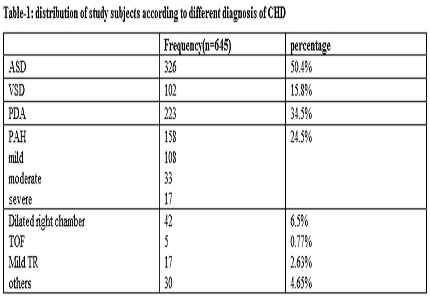Screening of high risk neonates for congenital heart defects: A study in level III neonatal intensive care unit
Abstract
Introduction: Congenital heart defects are most common birth defects representing a major global health problem. So, early screening of high risk newborns for congenital heart defects is essential foe early intervention thereby help us to reduce morbidity and mortality. It is very important to screen all high-risk newborn for congenital heart defects, early identification and management to reduce mortality and morbidity in tertiary care neonatal intensive care unit. Pattern of CHDs is essential to predict management and outcome.
Methods and Materials: A one year prospective study was carried out in a level III neonatal intensive care, Department of pediatrics, Bangalore Medical College and Research Institute, Bangalore, Karnataka, India, from October 2015 to September 2016. All high-risk newborns were screened for congenital heart defects through transthoracic 2D echocardiography. Patent foramen ovale in preterm was excluded. Retrospectively maternal risk factors were studied.
Results: Total live births during the study period were 15127. And total admissions to our neonatal intensive care were 4531 cases. High-risk newborns screened for congenital heart defects are 1324 cases during the study period. Among 1324 newborns screened, 645 cases (49%) were having CHDs, 679(51%) were normal. Among CHDs 326 babies had ASD, 102 babies had VSD, 223 cases had PDA, and 35 cases had cyanotic congenital heart defects.
Conclusions: Nearly half of the high risk newborns had CHD, thus it’s very essential to screen them at the earliest. Majority of CHDs were cyanotic type of CHDs. Preterm babies, babies born to diabetic mothers and babies who had severe respiratory distress requiring prolonged ventilator support are highly prone for having underlying CHDs. Babies born to mothers who had antenatal folic acid supplementations were less likely to have CHDs.
Downloads
References
2. Saxena A. Congenital heart disease in India: a status report. Indian J Pediatr. 2005 Jul;72(7):595-8. [PubMed]
3. Bhat NK, Dhar M, Kumar R, Patel A, Rawat A, Kalra BP. Prevalence and pattern of congenital heart disease in Uttarakhand, India. Indian J Pediatr. 2013 Apr;80(4):281-5. doi: 10.1007/s12098-012-0738-4. Epub 2012 Apr 11. [PubMed]
4. Smitha R, Karat SC, Narayanappa D, Krishnamurthy B, Prasanth SN, Ramachandra B, et al. Prevalence of congenital heart diseases in Mysore. Indian J Hum Genet.2006;12:11–6. [PubMed]
5. Kumar RK. Universal heart coverage for children with heart disease in India.Ann PediatrCardiol. 2015;8:177–83. [PubMed]
6. DC Dutta, HiralalKonar. Meconium Aspiration Syndrome. Text book of obstetrics including Perinarology and Contracepation. Seventh Edition. 2013 Nov; 477.
7. Renu Mishra. Ian Donalds Practical Obstetric Problems.Seventh edition. 2013;86.
8. Mertens L, Seri I, Marek J, Arlettaz R, Barker P, McNamara P, Moon-Grady AJ, Coon PD, Noori S, Simpson J, Lai WW. Targeted Neonatal Echocardiography in the Neonatal Intensive Care Unit: practice guidelines and recommendations for training. Writing Group of the American Society of Echocardiography (ASE) in collaboration with the European Association of Echocardiography (EAE) and the Association for European Pediatric Cardiologists (AEPC). J Am Soc Echocardiogr. 2011 Oct;24(10):1057-78. doi: 10.1016/j.echo.2011.07.014.
9. Hussain M, Tahura S, Sayeed MA, Rahman MM, Rahman MM, Kar SK. Past and present pattern of congenital heart disease at DSH: A situation analysis. Bangladesh J Child Health.2010;34:51–5.
10. Amro K. Pattern of congenital heart disease in Jordan. Eur J Gen Med. 2009;6:1615.
11. Kumar BD, Reddy KR, Elizabeth B. Study of incidence of congenital heart diseases in children of age group 1 month to 12 yrs. J Evol Med Dental Sci. 2015;4:1151–9.
12. Khan I, Muhammad A, Muhammad T. Pattern of congenital heart disease. Gomal J of Med Sci. 2011;9:174–7.
13. Botto LD, Mulinare J, Erickson JD. Occurrence of congenital heart defects in relation to maternal mulitivitamin use. Am J Epidemiol. 2000 May 1;151(9):878-84. [PubMed]
14. Scanlon KS, Ferencz C, Loffredo CA, Wilson PD, Correa-Villasenõr A, Khoury MJ, Willett WC. the Baltimore-Washington Infant Study Group. Preconceptional and folate intake and malformations of the cardiac outflow tract.Epidemiology.1998;9:95–8.
15. Hassan I, Haleem AA, Bhutta ZA. Profile and risk factors for congenital heart disease. J Pak Med Assoc. 1997 Mar;47(3):78-81. [PubMed]
16. Ishikawa T, Iwashima S, Ohishi A, Nakagawa Y, Ohzeki T. Prevalence of congenital heart disease assessed by echocardiography in 2067 consecutive newborns. Acta Paediatr. 2011 Aug;100(8):e55-60. doi: 10.1111/j.1651-2227.2011.02248.x. Epub 2011 Mar 24. [PubMed]
17. Dulskiene V,Malinauskiene V, Azaraviciene A, Kuciene R. [The incidence and diagnostics of congenital heart defects in Kaunas infant population during 1999-2005].Medicina (Kaunas) 2008; 44 (2): 139-146. [PubMed]
18. ShaadAbqari, Akash Gupta, TabassumShahab, MU Rabbani, S Manazir Ali, and UzmaFirdaus.. Profile and risk factors for congenital heart defects: A study in a tertiary care hospital Ann PediatrCardiol. 2016 Sep-Dec; 9(3): 216–221. doi: 10.4103/0974-2069.189119. [PubMed]
19. Qu Y, Liu X, Zhuang J, Chen G, Mai J, Guo X, Ou Y, Chen J, Gong W, Gao X, Wu Y, Nie Z. Incidence of Congenital Heart Disease: The 9-Year Experience of the Guangdong Registry of Congenital Heart Disease, China. PLoS One. 2016 Jul 13;11(7):e0159257. doi: 10.1371/journal.pone.0159257. eCollection 2016.

Copyright (c) 2017 Author (s). Published by Siddharth Health Research and Social Welfare Society

This work is licensed under a Creative Commons Attribution 4.0 International License.


 OAI - Open Archives Initiative
OAI - Open Archives Initiative


